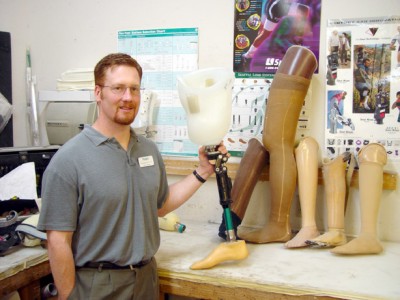Hanger Prosthetics & Orthotics Helps Patients Cope With Illness and Injury
Hanger Prosthetics & Orthotics Helps Patients Cope With Illness and Injury

Medical technology has improved by leaps and bounds in the past century, making what were once considered devastating medical conditions circumstances that many patients view as mere challenges rather than handicaps. Advances in the field of prosthetic design have been a driving force toward improving the quality of life for many patients. Hanger Orthopedic Group Inc., the parent company of Hacienda's Hanger Prosthetics & Orthotics, is the oldest and largest maker of prosthetics and orthotics in the United States. Hanger Orthopedic Group operates more than 600 patient care practices with over 1,000 clinicians in 42 states, including the District of Columbia.
Orthotics is the field of custom design, fabrication and fitting of braces and supports for treatment of musculoskeletal conditions resulting from illness, injury, or congenital anomalies. Prosthetics is the field of custom design, fabrication and fitting of artificial limbs typically required by those who have suffered the loss of a limb at birth, from vascular disease, diabetes, cancer or trauma.
Hanger Prosthetics & Orthotics, located at 5880 W. Las Positas Boulevard, specializes in designing and fitting artificial limbs and orthopedic braces. "We do custom bracing from head to toe," says Richard Sire, manager of Hanger's Pleasanton location. "That would include anything from a cervical halo for a neck fracture down to knee braces and foot orthotics." Hanger Prosthetics & Orthotics has been serving patients in Hacienda Business Park for over a decade. Its 8,000 square foot facility provides full patient care with three practitioners on staff to treat patients and on site technicians who can create prosthetic and orthotic devices. In addition to its Pleasanton office, Hanger also has a state of the art fabrication facility in Livermore.
James Edward Hanger, the company's founder, was the first amputee of the Civil War. After losing his leg in a battle, Hanger developed an artificial leg out of wood, first for himself and later for other Confederate amputees in the area, which is how the company began back in 1861. The life-changing power of prosthetics and orthotics is well told in the story of how Sire got into the business. "I was planning on going into physical therapy but one of the classes I was taking required us to do volunteer work. I picked an orthotic and prosthetic facility at random. My first day there, a gentleman who had his leg amputated above the knee arrived in his wheelchair for his final fitting. He ended up walking out. He put the wheelchair in his car and drove off. That got me hooked."
Hanger takes pride in giving its patients access to the latest developments in prosthetics and bracing. The company works with upper extremity myoelectrics, which use the small electrical signals created by the human body to control motors in the hand, wrist, or elbow of a prosthetic to produce movement. Another recent development is the C-Leg, which is computerized prosthetic leg that has a microprocessor in the knee to help an amputee walk better. Improvements in the field of prosthetics are continual, so the practitioners at Hanger are constantly learning. "There are always new types of components, like prosthetic feet and knees," Sire says. "Safer and lighter components are always being designed."
Photo: Richard Sire, C.P.O., with some examples of the prosthetic devices used by his firm.
Also in this issue...
- Polycom Starts the Year With Numerous New Products
- Class is in Session at the Pharmacy Technician Institute
- Business Bits
- Executive Profile: Adam Vali, deb Construction
- Cornish & Carey Commercial Serves Landlords and Tenants
- Hanger Prosthetics & Orthotics Helps Patients Cope With Illness and Injury
- Downtown Pleasanton Boasts Big City Attractions With A Small Town Feel
- TTEC's Corporate Membership Program Enhances Economic Growth
- New Route 70 WHEELS Service Hits the Road
- Businesses Compete in City's Corporate Games
- RIDES Offers Vanpoolers A Cash Incentive
- Hacienda Index




